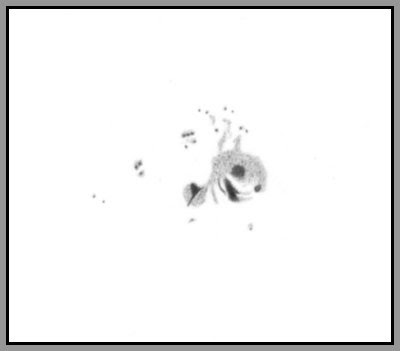Despite my involvement in amateur astronomy since the late 1960's, I still consider myself a beginning, visual observer. There is much that I still do not know; and I'm continually learning more. Take Venus for instance:
Back in the late 60's I made observations of Venus using an inexpensive, 60 to 65mm refractor. My observations showed the changing phases of the planet. I was able to see how the apparent size of the planet varied as Venus travelled around the Sun. The planet appeared noticeably smaller when near full, on the far side of the Sun than it did when near new, on the near side of the Sun. Venus was a brilliant, white, featureless planet - excepting only its changing apparent size and phase.
Only rarely since those early observations have I re-visited Venus. I had rarely, if ever, heard other amateurs mention observations of albedo variations on Venus. There seemed little point in observing a planet on which one cannot see surface nor atmospheric features.
This year my attitude toward Venus has changed. The change had its origins in a thread pertaining to the visual observation of Venus in the Usenet group:
sci.astro.amateur. Apparently, some people could see a sharply defined (yet, pretty much featureless) planet when they observed Venus through their telescopes, while others could see little more than a bright, boiling blob of ever-changing color.
In the saa discussion, mention was made of the visibility of subtle, atmospheric details that some have claimed to see. So, I decided to start observing the planet on a more or less regular basis with my current arsenal of telescopes and filters - to see what I could see . . .
After experimenting with filters, I found that a green filter (with or without a Moon-SkyGlow filter) seemed to work best on Venus for my eyes. As a result, most of my subsequent Venus work has involved the use of a green filter.
I soon found myself "suspecting" subtle detail in the Venusian clouds; but it took a while before I felt confident enough to attempt sketches of those details. Within this blog I often prefaced references to Venusian details with the qualifier: "suspected". This was because I was not fully convinced that the subtle details that I saw were truly details within the Venusian clouds. When observing near one's limits, other factors can enter the equation. The human eye, for instance, is a far from perfect optical instrument.
As I made more observations, I became more convinced that I was seeing actual albedo variations on Venus. Nevertheless, due to their subtle nature and the less than perfect seeing conditions it has remained difficult to record those variations with a high degree of confidence and/or accuracy.
I take my own Venus observations with a grain of salt. The main reason for this self-scepticism has to do with the subtleness of the suspected details. Observing detail on Venus is not like looking out a window and seeing a tree. It's more like looking out a window on a very foggy morning and "suspecting" a tree. In the case of Venus, atmospheric turbulence (in Earth's atmosphere) causes subtle planetary detail to be visible sometimes and invisible at other times - during the same observing session. It's necessary to patiently study the planet in the eyepiece, waiting for the detail to show itself. It's very much like catching intermittent glimpses of a tree as the fog thickens and thins.
Atmospheric turbulence was noticeably less problematic during my last Venus observation. The subtle Venusian details could be seen more consistently than ever before. Furthermore, I was using my largest telescope (and a green filter). Also, Venus was nearer to Earth and thus appeared larger than it had for my earlier observations. For that observation, I can remove the qualifier; "suspected". Detail was very definitely being seen, and that detail originated within the Venusian atmosphere.
So what about the boiling, colorful blob that some see when they look at Venus?
When conducting a test, the only time I could see color around Venus when using my Newtonian (a telescope type that does not suffer from chromatic aberration) without filters was either when I viewed the planet using an eyepiece that was poorly corrected for chromatic aberration, or when I waited for Venus to settle lower in my sky -- allowing Earth's atmosphere to bend the different colors by noticeably different amounts.
Of course, the "boiling" aspect that some have mentioned is due entirely to thermal effects in the line of sight between the observer's eye and the planet. More specifically, these thermal effects exist either in the air above the telescope, in the air inside the telescope, or both.
Some telescopes are less susceptible to internal thermal effects than others. Some observers exercise more care in avoiding telescope thermal effects than others. Some observing sites are better than others. Certain times of the year may be better than other times for a given location. Venus is not equally high in the sky near local sunset for observers observing from different latitudes. The list goes on . . .
I'm fully convinced that Venus can be an interesting and rewarding planet to observe for those willing to devote the necessary time and effort.




